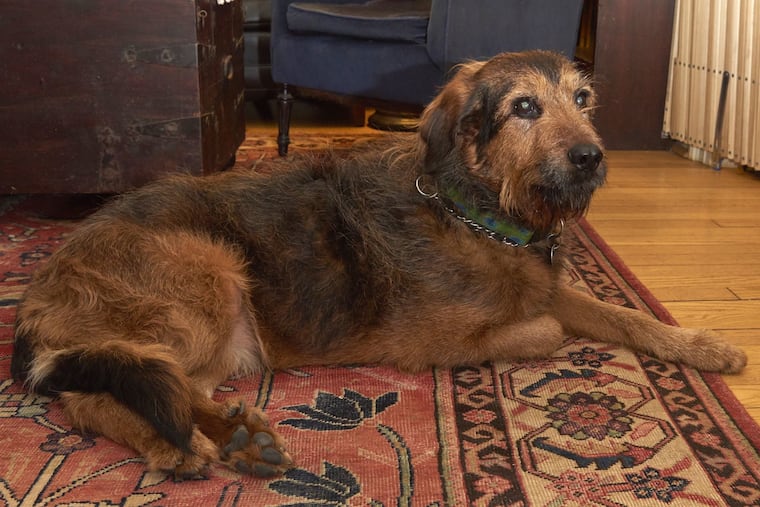Main Line dog, used to help cure blindness in humans, dies at 12
The Swedish Briard spent her days watching birds and squirrels.

Venus Bennett, the shaggy dog who helped reverse an inherited form of blindness in humans, died last month after a short illness.
The 12-year-old Swedish briard, a herding breed, was born with Leber’s congenital amaurosis. The condition is caused by the RPE65 gene mutation and primarily affects the retina, which detects light and color. The disease affects about 3,500 people in the United States and Europe. Though relatively rare, it is one of the most common causes of blindness in children.
Venus was one of six dogs that underwent an experimental gene therapy treatment at the University of Pennsylvania to help reverse her blindness. The one-time treatment was administered under anesthesia by a single injection into the eye. It delivered a genetically engineered virus that carried a healthy copy of the gene, which makes a vital light-sensing protein, to the retina.
Clinical trials for the treatment in humans began in 2007 after it was found safe and effective in dogs.
“It has transformed [kids'] lives and their parents’ lives,” said Jean Bennett, a University of Pennsylvania ophthalmologist and researcher who, along with her husband, Albert Maguire, a Penn ophthalmologist and CHOP physician, carried out the animal studies for the disease.
Venus and Neptune, her mate who also had the condition, were originally obtained by Bennett for research.
The treatment drug, Luxturna, was developed by Philadelphia drugmaker Spark Therapeutics and researchers at Children’s Hospital of Philadelphia and the University of Pennsylvania. It was approved by the Food and Drug Administration in December 2017 as the first gene therapy targeting a disease caused by mutations in a specific gene. A year later, it was approved by the European Medicines Agency.
The total cost for treating both eyes is about $1 million.
Although it doesn’t completely restore vision, patients who received the treatment said it changed their lives by giving them some ability to see. The treatment produces an enzyme that converts light into electrical signals that are interpreted by the brain.
Children who once could not see in dim light, after treatment could walk to class without having to count steps, see the stars in the night sky, make out fine details, and even play sports.
“It has allowed people to take jobs for the first time, to graduate from college, see loved ones, and see wrinkled faces for the first time,” Bennett said. “It has been huge.”
More than 20 children have been treated in Philadelphia, she said. There are now 10 sites in the U.S. that offer the treatment and more in Europe. It takes time for surgeons to become trained in the procedure, she said.
Venus was bred by a Swedish veterinarian, who identified the condition in her line, with hopes that the breed would be useful in developing a treatment for the disease in humans. Venus’ cousin Lancelot was also treated using an initial version of the drug and became a frequent visitor to Congress to lobby for more research funding.
When Venus first arrived in Philadelphia, she was very nervous and scared and would jump if touched, probably a result from not being able to see, Bennett said.
Bennett spent a lot of time with the dog, just talking to her, and the two become fast friends. She helped deliver Venus’ four puppies, which were also bred for research.
Before the treatment, Venus preferred to crouch in a corner for fear of bumping into objects. But after the treatment, it was clear that Venus and the other dogs were able to see. They could easily navigate obstacle courses set up by researchers. Venus was a new dog, eager to walk around and explore grass, birds, and squirrels for the first time.
“She loved being put on a leash,” said Bennett.
In 2010, Venus and her pup Mercury were adopted by Bennett and Maguire. The couple petitioned the university to release the dogs after the study was completed, though occasionally the dogs returned for follow-up evaluations, Bennett said.
“I felt she contributed so much she deserved to live a life outside the animal facility,” she said.
The pair thrived in their Bryn Mawr home, she said.
Venus loved to go hiking and sit in the grass and watch Bennett garden. She also enjoyed lounging under the family piano when it was being played, as if listening to private concerts, Bennett said.
“She was like part of our family,” said Bennett. “She lived a pretty amazing and long life for this breed.”
Mercury acted like a puppy and would run around playing with other dogs. He enjoyed exploring, new smells, and drinking out of the toilet.
“He’s got great eyesight,” she said. “You would never know he was impaired.”
Venus will long be remembered both as a sweet pet and for her contribution to biomedical research.
“We are lucky to have lived with her and experienced what she experienced,” Bennett said.